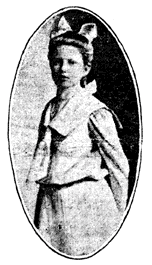Anna Keichline
| Anna Wagner Keichline | |
|---|---|

Keichline in 1903
|
|
| Born | 1889 Bellefonte, Pennsylvania |
| Died | 1943 (aged 54) |
| Nationality | American |
| Occupation | Architect |
Bellefonte, Pennsylvania
Anna Wagner Keichline (1889–1943) was an American architect, inventor, suffragist, and World War I Special Agent from Pennsylvania. She was the first registered female architect in Pennsylvania and she was "the first woman to actually practice architecture professionally".
Keichline was the youngest of four children, born in Bellefonte, Pennsylvania to attorney John Keichline. Her parents gave her a workshop and carpentry tools, which she used to create furniture. She won a prize for a table and chest she made at a county fair in 1903, when she was 14, and her work was praised as comparing "favorably with the work of a skilled mechanic". She told a newspaper reporter that she expected to devote her life to industrial design. She graduated from Bellefonte High School in 1906. She studied mechanical engineering for a year at Pennsylvania State College, the only woman in her class, and moved to Cornell University, graduating in 1911, their fifth female to receive an architecture degree. She played basketball at Cornell, served as class officer, and was a sorority and drama club member. Keichline was definitely aware of the disadvantage and difficulty being a woman in architecture– a male dominant field– but she was not discouraged. She was convinced that women could be just as successful because of their innate understanding of space in a home.
She became noted for working on "time- and motion-saving" design of kitchens and interiors. She owned seven patents. She had several inventions concerning home use, but her most noted invention was the "K Brick" in 1927. This type of hollow clay brick was less heavy and expensive than previous iterations and was an early form of the concrete block used in construction decades later. This led to her receiving honors from the American Ceramic Society in 1931.
Her first patent combined a sink and a washtub. She wanted to save space in kitchens and make them more comfortable to use. In 1924 she received a patent on one of her kitchen designs. The design was focused on "comfort and convenience, efficiency, and conservation of space." This kitchen featured sloped countertops and cabinets with glass doors. In 1929 she received a patent on an apartment bed design. It could be flipped into the wall to save space.
...
Wikipedia
